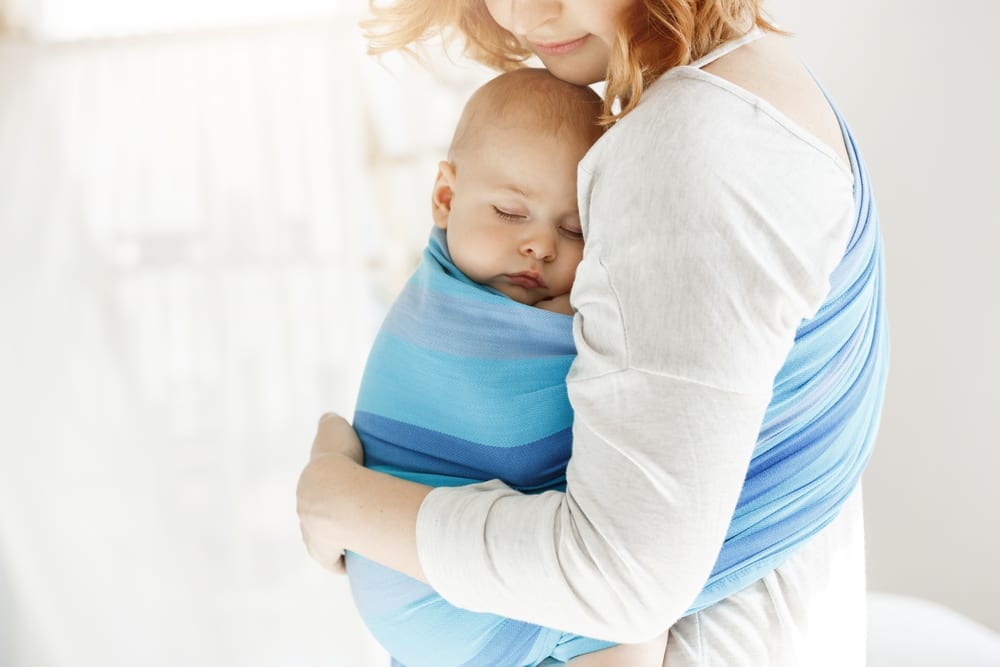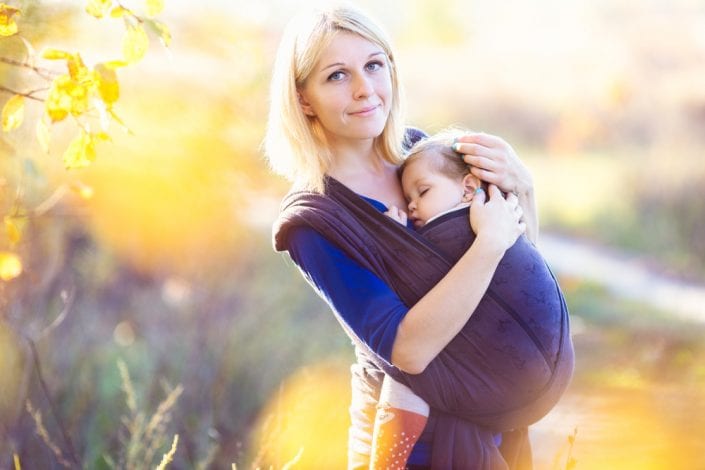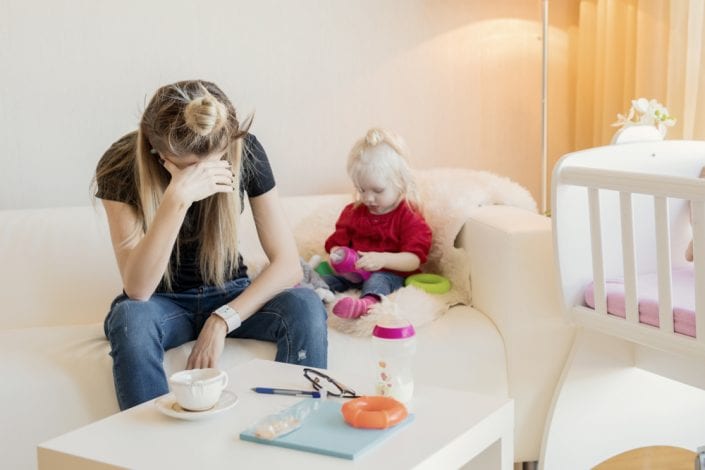It’s an increasingly popular approach with an emphasis on baby wearing, breastfeeding and co-sleeping. But does attachment parenting make happier babies and, just as importantly, happier parents?
Some argue it is the most ‘natural’ way to bring up a child.
At a time when we are bombarded with (often conflicting) parenting advice and ‘rules’, attachment parenting allows us to be more in sync with our baby’s needs.
Rather than following ‘strict’ advice from professionals to let a baby cry it out or follow a set schedule attachment parenting is guided by baby.
What is attachment parenting?
Attachment parenting was developed in the 1980s by the American paediatrician William Sears and his wife Martha, a registered nurse.
It’s all about creating a special relationship with your baby by staying physically close from birth.
This is done by practising things like breastfeeding, baby-wearing (carrying your baby in a sling for as long as possible) and co-sleeping.
This promotes a secure bond and attachment between baby and mother.
Instead of trying to fit a baby into her schedule, a mother is led by her baby, responding to her needs immediately and ‘respectfully’.
It’s based on the idea that babies learn to trust and thrive when a parent constantly meets their needs promptly in their early years.
It’s a growing movement with official organisations in the US and the UK and a number of popular Facebook groups.
Attachment Parenting UK (APUK) is a group set up by a mother, Michelle McHale, in 2012.
Dr Sears has streamlined and updated the principles of attachment parenting, which he calls:
The 7 Baby B’s of attachment parenting:
 Birth bonding. Lots of skin-to-skin contact to promote a solid bond after birth.*
Birth bonding. Lots of skin-to-skin contact to promote a solid bond after birth.*- Breastfeeding. Sears encourages exclusive breastfeeding for as long as a mother feels her baby needs it.
- Baby-wearing. Carrying your baby or toddler in a sling or wrap to promote attachment. Giving frequent touch to increase parents’ sensitivity to an infant’s cues of needs.
- Bedding close to baby. Usually by co-sleeping.
- Belief in the language-value of your baby’s cry. Responding immediately to your baby’s cries.
- Beware of baby trainers. These are things that put a parent’s convenience before the needs of their child. Examples are parent-scheduled feedings or sleep training that involves letting your baby ‘cry it out’.
- Balance. Sears’ advice on attachment parenting includes strong advice to parents to balance parenting, marriage, and their own health and emotional needs.
*Sears now acknowledges that there is not a now-or-never window for close bonding. He recognises that adopted children, children who are fostered and mums who are separated from their babies after birth because they are in special care, can all compensate for any immediate separation by practising attachment parenting to build a bond.
Can you do attachment parenting if you bottle feed or don’t co-sleep?
Both Dr Sears and Michelle McHale reassure parents that if you can’t do all, or even one of the things on this list then you can still do attachment parenting.
McHale says that:
simply responding to young children sensitively and consistently, using positive discipline, and following their instincts, all counts.
Sears stresses that it isn’t necessary for parents to follow all of the Baby B’s.
They are all designed to help parents achieve the goals of being sensitive and responsive to their children. Parents can experiment and see what works.
He stresses that
AP is an approach, rather than a strict set of rules.
The website Attachment Parenting International states on its website that parents should
take what works and leave the rest.
What are the benefits of attachment parenting for children?
Researchers have looked into the ways attachment parenting can benefit children. Various studies suggest that babies with a secure attachment may grow up to be:

More confident
They are able to go off into the world and explore, safe in the knowledge that their parents will be there for them. (Mercer, 2006)
More open with their feelings
They are able to more openly discuss emotions and respond well to the emotions of others. (Easterbrooks et al 2000)
Better behaved
Sears claims that babies are less fussy and cry less. An observational study found that securely attached children were less likely to develop behavioural problems . (Madigan et al 2015)
Happier at school
An American study found that children brought up by attached parenting showed “higher levels of positive mood, more constructive coping, and better regulation of emotion in the classroom.” (Kerns et al 2007).
What about the benefits for parents?
Sears claims that attached parents:
- become more confident
- are more sensitive
- can read baby’s cues
- respond intuitively
- flow with baby’s temperament
- find discipline easier
- become keen observers
- know baby’s competencies and preferences
- know which advice to take and which to disregard
What are the criticisms of attachment parenting?
Attachment parenting sounds like a very gentle, very natural and very cosy way of parenting. And if it works for you and for your baby and you are both happy and content then that is wonderful.
But this way of parenting does demand a lot from parents – and from mums especially.
Being so close to your baby both by day and, if you are co-sleeping, by night means that mums do not get much time to be alone and to recharge their batteries.
Writing for The Huffington Post, one mum, Lynn Shattuck, described how attachment parenting eventually made her feel exhausted and frustrated, especially as her son grew up to be a toddler. She writes:
…after months and months of Max waking up every hour or two all night long, I was unraveling. I was anxious, depressed and exhausted. I had some very real needs of my own. I needed to get some sleep.
I needed to not go to bed with Max at 7:00 p.m. every night, my boobs on pacifier duty until morning. I needed to have some time with my husband.
Should my almost-toddler’s wants outweigh my needs?
Didn’t Max need and deserve a mom who didn’t feel like a wrung out washcloth? One who wasn’t so battered by sleep deprivation that she shouldn’t be driving?
And wouldn’t it be good for him to get a decent night’s sleep?
One of the biggest criticisms of attachment parenting is that it encourages parents to put the needs of their child over those of each other.
In an interview in The Guardian Liza, a mother of four who co-sleeps with her 2 year old told the researcher:
My husband sleeps on the sofa, and that’s his choice. The sound of my daughter whining in the night woke him and we realised that, when he slept on the sofa, everyone slept better.
Attachment Parenting websites do have a lot of advice for parents about how to maintain a close relationship as well as a sexual one, even if they are not sharing a bed.
The advice is usually to make love at different times of the day when the children are sleeping, or in different places other than the bed.
There’s a slogan amongst AP parents ‘AP parents do it on the kitchen table’. Some family psychologists argue that attachment parenting places a lot more strain on couples than other styles.
Andrew G Marshall is a marital therapist and the author of a book called ‘I love you but you always put me last’. He argues:
When the dad is sleeping on the sofa, the mother is telling him she has left him for the kids, and she is telling her children that they are more important than their father.
Attachment parenting tells women to strive for a balance in family and personal life, but everything it then says undermines that. It definitely has more of an impact on couples than other kinds of parenting.
Parenting is all about finding out what works best for YOU and your baby
There may be all or some aspects of attachment parenting that appeal to you and/or work for you. Other parts might just not feel like the right thing to do for either your baby, yourself or for your relationship.
Always remember that there is no such thing as a perfect parent. It’s all about finding ways to be the best and happiest parent you can be. Sometimes that means trying different things until you find what feels best and works best for you.
Dr Amy Tuteur is the author of a book called ‘Push Back: Guilt in the Age of Natural Parenting’. Her words are worth remembering whenever you feel unsure:
There are a lot of excellent ways to raise children and it isn’t the details that matter – it’s the love.
A note on co-sleeping
The Lullaby Trust recognises that some parents choose to co-sleep with their babies but highlights important information that all parents should be aware of to minimise the risks. They say:
It is important for you to know that there are some circumstances in which sharing a bed with your baby can be very dangerous.
Bed sharing itself increases the chance of SIDS and is particularly dangerous if:
- Either you or your partner smokes (even if you do not smoke in the bedroom)
- Either you or your partner has drunk alcohol or taken drugs (including medications that may make you drowsy)
- You are extremely tired
- Your baby was born premature (37 weeks or less)
- Your baby was born at a low weight (2.5kg or 5½ lbs or less)
You should never sleep together with your baby if any of the above points apply to you. You must be especially careful when giving feeds that you are not in a position where you could both fall asleep in the bed together.
Never sleep on a sofa or on an armchair with your baby. Sleeping on a sofa or armchair with your baby can increase the risk of SIDS by 50 times.
If you choose to share a bed with your baby:
Ensure there are no pillows, sheets, blankets or any other items in the bed with you that could obstruct your baby’s breathing or cause them to overheat. A high proportion of infants who die as a result of SIDS are found with their head covered by loose bedding.
The safest place for your baby to sleep for the first 6 months is in a separate cot or Moses basket in the same room as you.


 Birth bonding. Lots of skin-to-skin contact to promote a solid bond after birth.*
Birth bonding. Lots of skin-to-skin contact to promote a solid bond after birth.*
